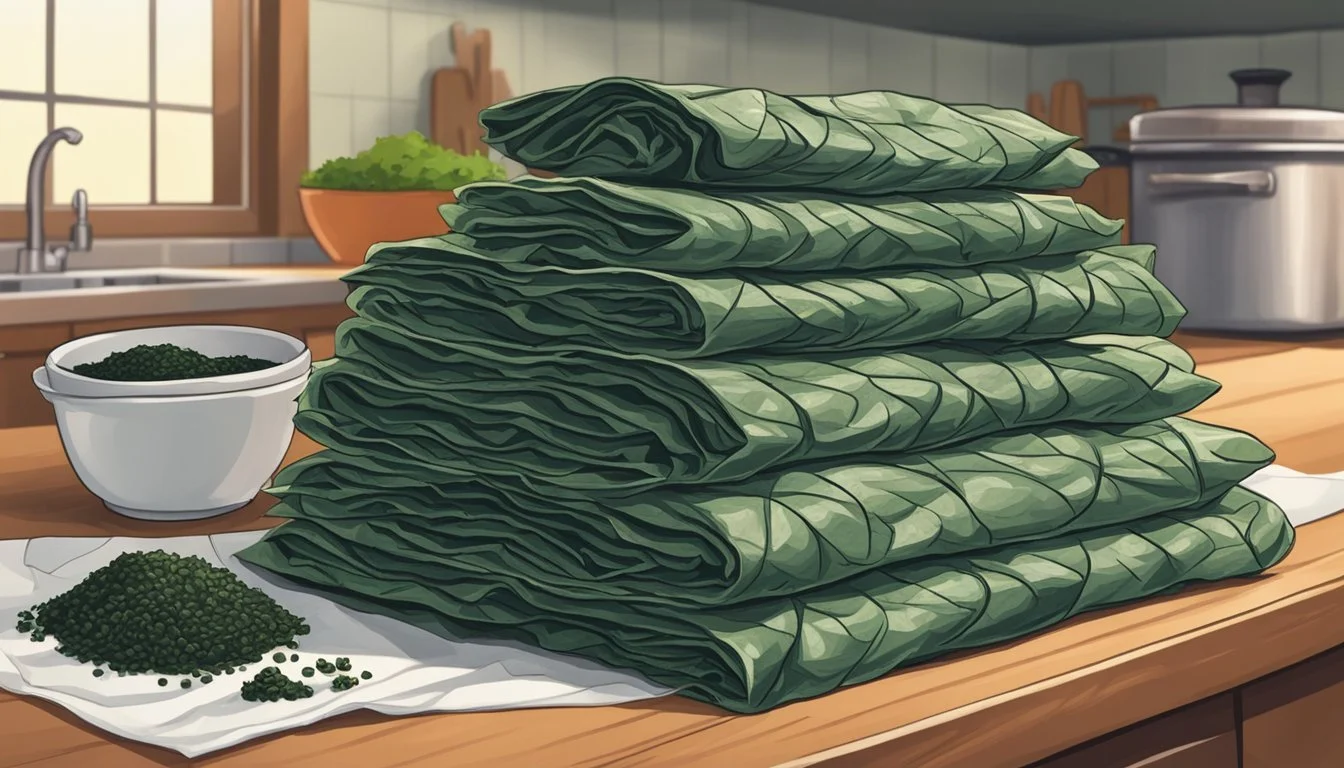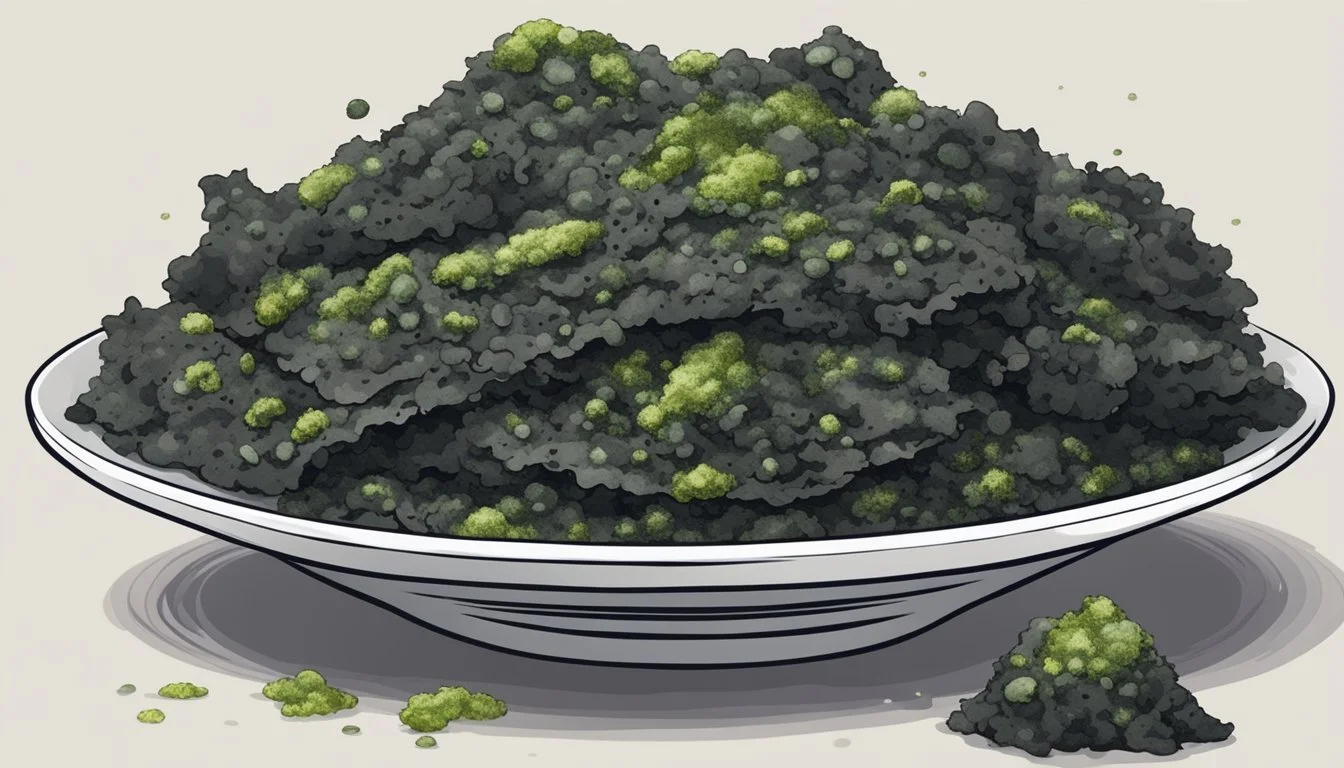Does Nori Go Bad?
Understanding Shelf Life and Storage
Nori, a type of edible seaweed, is an essential ingredient in Japanese cuisine, known for its unique flavor and pivotal role in making sushi. But like many pantry items, one might wonder whether nori goes bad. Nori can maintain its quality for 2 to 3 years if properly sealed and stored, offering a lengthy shelf life for enthusiasts and occasional users alike.
The longevity of nori depends on its storage conditions. Exposure to air and moisture can degrade its quality, causing a loss of crispness and taste. Keeping it in an airtight container helps preserve its flavor and texture, ensuring it's ready for your next culinary adventure.
For those with large quantities of nori, placing it in the freezer can extend its freshness even further. While this step isn't necessary for general use, it can be a convenient method to maintain quality, especially if the nori won't be used immediately. With proper care, nori remains a long-lasting staple in any kitchen.
Understanding Nori
Nori is a type of seaweed, often used in Japanese cuisine. It is commonly found in sushi rolls and is known for its umami flavor, making it a popular addition to various dishes.
Nori contains several nutrients that contribute to its nutritional benefits. It is rich in iron, calcium, and iodine. Iron supports the body's production of red blood cells, while calcium aids in bone health.
Iodine is crucial for maintaining thyroid function, which regulates metabolism.
Vitamins found in nori include vitamin A, vitamin C, and various B-complex vitamins. These contribute to overall health by supporting immune function and energy production.
In terms of minerals, nori provides magnesium and potassium, both of which are essential for muscle function and heart health.
The health benefits of nori come from its high concentration of nutrients. Regular consumption can contribute to a balanced diet and promote overall well-being.
Storing nori properly, typically in a cool, dry place, ensures it retains its flavors and nutritional value. Most nori can last 2-3 years if unopened and kept at the right conditions.
For optimal storage, refrigeration is recommended to prevent bacterial development. If stored correctly, nori remains a nutritious and flavorful addition to meals.
By incorporating nori into a diet, individuals can enjoy both its unique taste and nutritional benefits.
Quality Indicators of Nori
Nori’s quality can be assessed by examining its visual and texture characteristics as well as its aroma and flavor profile. Specific signs of freshness include vibrant color, crisp texture, and a clean, oceanic aroma.
Visual and Texture Characteristics
Nori should ideally have a deep green or dark purple color. If the color appears faded, it may indicate degradation. Fresh nori is also crisp and brittle when dry. Stale or spoiled nori often feels damp, soft, or soggy. The texture should be uniform, with no noticeable tears or holes. Properly stored nori will maintain these characteristics for a prolonged period.
Aroma and Flavor Profile
Fresh nori has a clean, slightly salty seaweed aroma. If it smells fishy, moldy, or overly pungent, it is likely past its prime. The flavor should be mild and umami-rich, with a hint of sweetness. Stale nori might taste off, with a pronounced bitterness or a lack of flavor. Assessing both aroma and flavor is crucial in determining the nori’s freshness.
Proper Storage Techniques
Ensuring that nori stays fresh involves using specific storage methods depending on whether the package is sealed or opened. Maintaining low temperatures and keeping it dry are critical steps in preserving its quality.
Before Opening
Unopened nori packs can last up to 2-3 years if properly stored. The ideal storage environment is a cool, dry place away from direct sunlight.
Pantries, cupboards, or even refrigerators work well as long as the temperature stays between 35 and 38 degrees Fahrenheit. It's crucial to keep the nori in a sealed package to prevent exposure to air and moisture. Adding silica gel packets inside the storage container can help absorb any residual moisture.
After Opening
Once nori packs are opened, their shelf life shortens to 1-2 years, provided they are stored correctly. Transfer the nori into airtight containers or resealable plastic bags to limit air exposure.
Press out any excess air before sealing to maintain freshness. Adding silica gel packets inside the container can help keep the nori dry. Label the package with the storage date to keep track of its freshness. For infrequent use, consider freezing nori; ensure it's well-wrapped to protect it from moisture.
Signs of Spoilage in Nori
Recognizing spoiled nori is important to avoid potential health risks. Various signs such as mold development, discoloration, changes in taste and odor, and physical deterioration can indicate that nori is no longer safe to eat.
Spotting Mold and Discoloration
Mold is one of the clear indicators of spoilage in nori. Look for any unusual spots, especially those that are greenish, bluish, or black. Discoloration can also signify that the nori has gone bad. Fresh nori maintains a consistent dark green to black shade, while spoiled nori may show brown or yellowish patches. Presence of mold or inconsistent coloration should signal that the nori should be discarded.
Changes in Taste and Odor
The odor of nori is another critical factor in identifying spoilage. Fresh nori typically has a pleasant, ocean-like scent. Spoiled nori may emit a fishy, moldy, or stale smell. These odors suggest bacterial or fungal growth. Taste is also a reliable indicator: fresh nori has a crisp, mild flavor, whereas spoiled nori may taste off, bitter, or overwhelmingly fishy. Any abnormalities in smell or taste mean the nori is likely unsafe to eat.
Physical Deterioration
Physical changes can also indicate that nori has gone bad. Fresh nori is dry, crisp, and easily breaks. Spoiled nori loses its crispiness and might become soft, mushy, or slimy. Brittleness or excessive dryness can indicate that the nori is past its prime. Additionally, any signs of unusual texture due to moisture exposure or improper storage should alert that the nori has deteriorated.
Health Risks of Consuming Spoiled Nori
Eating spoiled nori can pose significant health risks. One primary concern is food poisoning, which can occur when nori is past its prime or improperly stored.
Symptoms of food poisoning from spoiled nori may include nausea, vomiting, diarrhea, and headaches. In severe cases, a fever might develop, indicating a more serious interaction with harmful bacteria.
Spoiled nori often shows telltale signs, such as an unpleasant fishy or moldy smell. These changes signal bacterial growth or mold development, both of which can compromise safety.
Visual indicators of spoiled nori include discoloration and a slimy texture. When nori becomes brittle, it may also suggest degradation, although not always harmful.
Proper storage is essential to prevent spoilage. Nori should be kept in a refrigerator, ideally between 35°F and 38°F. This reduces the risk of bacterial growth.
If stored correctly, unopened nori can last for 2-3 years. Once opened, it may be safe for up to six months, though freshness and flavor might diminish.
Maximizing the Shelf Life of Nori
Proper storage practices ensure the longevity of nori, whether the packs are unopened or already in use. Attention to handling and environmental conditions is essential for maintaining its freshness.
Handling Unopened Packs
Unopened packs of nori benefit from their original packaging designed for preservation. Store these in a cool, dry place away from direct sunlight, as exposure to heat and moisture can lead to degradation.
Keep the nori packets in a pantry or cupboard that maintains a stable temperature. Pay attention to the best-by date, an indicator of peak quality, not safety. If you buy in bulk, consider dividing the packs into smaller portions to avoid repeated exposure to air, which can degrade the nori over time.
Best Practices for Opened Packs
Once opened, nori's longevity depends significantly on minimizing its exposure to moisture and air. Transfer the opened nori sheets to an airtight container or sealable plastic bag with a desiccant packet to absorb any ambient moisture.
Store the container in a cool, dry place, similar to unopened packs. For extra protection, avoid keeping opened nori in areas prone to humidity, such as next to stoves or dishwashers. Properly stored, opened nori maintains its quality for several weeks to a few months.
If unsure about its freshness, check for signs of moisture or changes in texture before use.
Incorporating Nori into Your Diet
Nori is a versatile ingredient that can be used in many traditional and modern dishes. Its unique flavor and texture make it a favorite in both Japanese and Korean cuisines.
Traditional and Modern Recipes
Sushi and Sushi Rolls: Nori is most commonly recognized for its role in sushi and sushi rolls. It provides the necessary structure to hold ingredients like rice, fish, and vegetables together. Sushi rolls can be simple, like a cucumber roll, or more complex with multiple ingredients.
Onigiri: Another popular use is in onigiri, or rice balls. Nori wraps around seasoned rice to create a portable snack. These can contain a variety of fillings like salted salmon, pickled plums, or tuna.
Korean Cuisine: In Korean cuisine, nori (referred to as gim) is used in dishes such as gimbap, where it wraps around rice and assorted fillings. It's also a popular addition to various soups and stews for added flavor and texture.
Creative Culinary Ideas
Salads and Garnishes: Nori can enhance salads, providing a salty and savory taste. Simply tear or cut nori into thin strips and sprinkle it over fresh greens or poke bowls.
Soups: Adding nori to soups is another way to incorporate its umami flavor. It dissolves quickly, making it perfect for miso soup or ramen.
Snacks: Nori can be eaten on its own as a snack. Roasted nori snacks are popular for their crunchy texture and subtle saltiness, available in various flavors like wasabi or sesame.
Garnish: Use nori as a garnish for dishes like scrambled eggs, avocado toast, or even baked potatoes. Its unique flavor profile can elevate simple dishes.
Here are a few creative ideas to try:
Nori Chips: Cut nori sheets into small pieces, brush with oil, and bake until crisp.
Nori-Seasoned Popcorn: Crumble nori over freshly popped popcorn for a tasty twist.
Incorporating nori into your diet offers both traditional favorites and innovative culinary possibilities.
Food Safety and Preservation
Proper storage methods can significantly extend the shelf life of nori. This includes understanding the roles of refrigeration, moisture control, and freezing in maintaining its quality.
Refrigeration vs. Room Temperature Storage
Storing nori at room temperature may seem convenient, but for optimal preservation, cooler environments are recommended. Refrigeration can prevent bacterial growth, which starts at around 40°F (4°C). Keeping nori between 35°F to 38°F (2°C to 3°C) ensures it remains fresh and safe for consumption.
Room temperature storage is less reliable due to fluctuations in humidity and temperature, which can degrade the quality of nori. Environments that are too humid or too warm might contribute to spoilage by promoting mold growth and reducing the crisp texture of nori.
Utilizing Desiccants for Moisture Control
Maintaining dryness is crucial for preserving nori, as moisture can quickly lead to deterioration. Desiccants are effective tools for controlling moisture levels within storage containers. These materials, often found in small packets, absorb excess moisture, thus maintaining an optimal humidity level for nori.
When storing nori, place it in airtight containers with desiccant packets to keep it dry. This practice is particularly important for opened packages, which are more susceptible to moisture absorption. Keeping nori dry helps to sustain its flavor, texture, and nutritional value for extended periods.
Freezing Techniques for Extending Freshness
Freezing is a practical method to considerably extend the shelf life of nori, particularly for those who use it sporadically. To freeze nori effectively, it should be placed in freezer-safe packaging. This protects it from freezer burn and moisture accumulation, which can compromise its quality.
Before freezing, ensure that nori sheets are completely dry. Once prepared, store nori in the freezer and thaw only the amount needed for immediate use. This approach helps in preserving the nori's texture and taste, making it a useful strategy for those who prefer to stock up on this essential ingredient.
Determining the Optimal Time to Use Nori
Understanding when nori is best to use hinges on examining expiration dates and noticing signs of freshness. Correct storage practices significantly extend its shelf life.
Interpreting Expiration and Best-By Dates
Nori packaging typically features an expiration date or a best-by date. The best-by date indicates when nori is at peak quality, while the expiration date suggests when it may become unsafe to consume.
Unopened nori can last 2-3 years from the production date. Once opened, it is best used within 1-2 years. However, the location of storage also matters. For instance, refrigeration or freezing can preserve its texture and taste better than a pantry. Proper sealing post-opening is essential to prevent moisture and air from degrading its quality.
Signs of Fresh Nori vs. Expired Nori
Fresh nori maintains a dark green to blackish color, crisp texture, and a subtle oceanic aroma. If nori is discolored, has a rubbery texture, or emits an unpleasant smell, it’s likely expired.
Storage temperature plays a critical role. It should ideally be stored between 35 and 38 degrees Fahrenheit to restrict bacterial growth. If stored improperly, even within the indicated timeframe, quality may degrade faster. Thus, always store nori in airtight conditions away from moisture and dramatic temperature changes to ensure its longevity.









